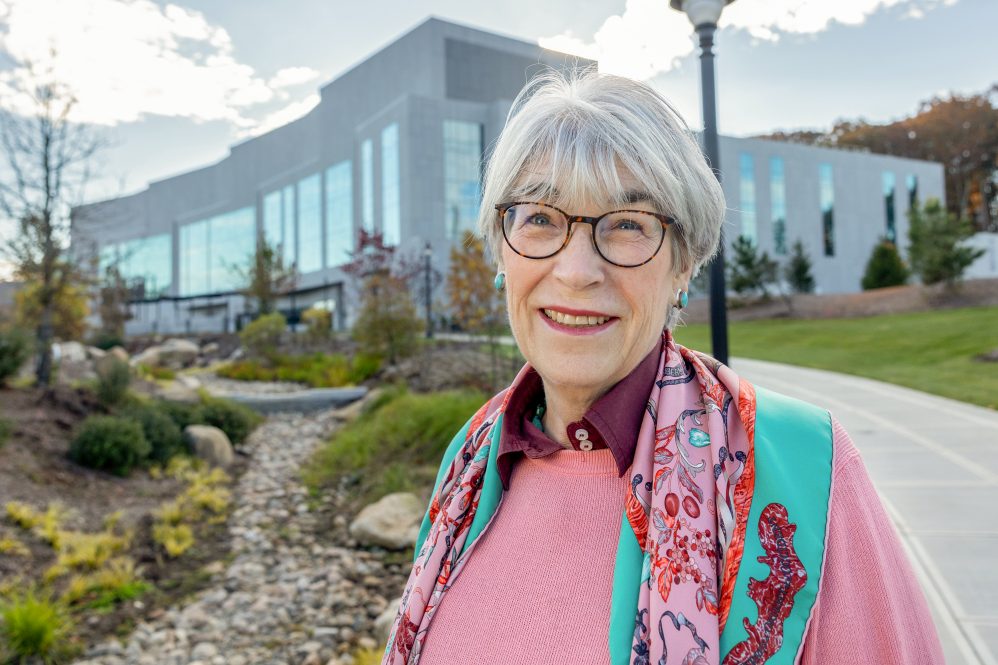Laura Cruickshank’s name doesn’t appear in huge letters on any UConn buildings, but as the University’s master planner and chief architect, her immeasurable expertise is embedded in academic, residential, and research structures throughout its campuses.
Cruickshank, who joined UConn in 2013 after eight years as Yale’s university planner and 20-plus years in private practice, has left such an imprint on Connecticut’s structural landscape that she was inducted this fall into the Connecticut Women’s Hall of Fame.
Fewer than 150 women have been selected for the distinction in the Hall’s nearly 30-year history. Cruickshank was inducted in a four-person class with the theme of “Women Who Build,” recognizing those who have blazed trails in traditionally male-dominated fields.
“It really is quite an honor, and she is in amazing company there,” says UConn Board of Trustees member Marilda Gandara ’78 JD, who chairs the board’s committee on building, grounds, and environment, which oversees the areas in which Cruickshank leads the University.
“They are very selective in who they choose for this distinction,” Gandara said of the Hall of Fame. “This is a very proud moment, both for Laura and for UConn as the beneficiary of all of the incredible work that she has accomplished.”
In addition to serving as UConn’s master planner and chief architect, Cruickshank is its associate vice president in charge of University Planning, Design, and Construction (UPDC), which leads billions of dollars’ worth of projects throughout UConn’s campuses.
Cruickshank’s role places her as a guiding force in the immediate and long-range planning for projects under the Next Generation Connecticut program, the most recent iteration of the UConn 2000 and 21st Century UConn campus transformation plans; UConn’s annual and long-term capital improvement projects; and its management of real estate, space allocation, and other duties.
Some of UConn’s largest projects completed under Cruickshank’s stewardship include the 198,000-square-foot Science 1 building, which opened earlier this year; the Innovation Partnership Building at the UConn Tech Park (2018), the Peter J. Werth Residence Tower (2016), formerly known as NextGen Hall; the new Engineering & Science Building (2018); the Student Recreation Center (2019); and many other renovations, expansions, and infrastructure improvement projects.
“Many architects and planners have a talent for holistic views of large properties, and many have a special flair for the small details. In Laura, we are fortunate to have someone whose talents cross the spectrum,” UConn President Radenka Maric says. “She has truly left her mark on UConn and the state of Connecticut in a way that will benefit students and residents for decades to come.”
One of the hallmarks of Cruickshank’s career at UConn, and the project that is closest to her heart, is the renovation and expansion of the old Hartford Times building into the UConn Hartford campus (2017).
“That project was not just about a building. It was really about transforming an entire campus,” she says. “It involved using a wide range of skills to consider the academic needs, the architecture and historic preservation of the site, its importance to the city and the region, and all of the other considerations, and it really turned out to be quite beautiful.”
In determining the look and functionality of UConn buildings, Cruickshank and her staff balance many considerations that require them to collaborate with on-campus partners along with multiple companies, organizations, and government agencies at the local, state, and federal levels.
The planning is multi-faceted and includes meeting the needs of the people who will work or live in the spaces, and ensuring the amenities and design won’t become quickly outdated. They also must complement nearby structures or land forms, meet budget and schedule expectations, and reflect the campus zeitgeist of honoring UConn’s history while setting the stage for its future.
“As an architect, I’m very visually oriented and I have the look and the feel of these projects built in my head long before they’re actually built on the ground,” says Cruickshank, whose interest in architecture was first piqued at age 12 when her engineer father built an addition to their house.
Cruickshank’s family split its time between the Westchester County and Catskills areas of New York as she was growing up, exposing her to differences in the development trends, building design, and cultures of suburban and rural areas.
As the oldest of seven children, Cruickshank grew up knowing how to bring order to situations with various personalities and priorities. She also attended an all-girls high school and a women-only college, and learned through participating in drama productions that consistent practice builds confidence.
Cruickshank says she considered career possibilities as varied as pre-med, English literature, and creative writing before deciding to pursue architecture.
From the start, she has never considered her gender to be a hindrance in the profession — though she is also keenly aware of the pressures that women face in the traditionally male-dominated fields involving planning, design, and construction.
In fact, Cruickshank says, she considers her pragmatic management and personality style to be somewhat androgynous, without worrying whether that directness may be viewed as too stereotypically male or whether some people might expect her to soften her approach.
She was surprised and honored to be selected for the Connecticut Women’s Hall of Fame, she says, adding that it brought her back to memories of her earliest female role model: the eye doctor she started seeing at age 10, the first professional woman she met and who took the time to talk with her about her interests and aspirations.
“She was a role model for me,” Cruickshank recalls. “It took me some time to accept the idea of myself as a role model, but I kept getting more and more feedback from others who said they were watching and learning from my work, particularly in design and construction.
“As I got more comfortable with the idea, I realized it comes with certain responsibilities, and it’s brought me a lot of joy to be able to encourage and support younger women on their own journeys,” she says.
She also has hired and mentored female workers at UPDC, which has a nearly equal balance of men and women in those roles — higher than in many other colleges and universities, and far above averages in the industry as a whole.
Cruickshank received her bachelor’s degree in urban studies from Mount Holyoke College and her master’s degree in architecture from the University of New Mexico’s School of Architecture & Planning, which invited her back in 2016 to deliver its Commencement address.
While in New Mexico, Cruickshank met her now-husband K. Bradley Mehrens. They have been married for 47 years and have an adult daughter and son, the latter of whom is a UConn alum.
After about 20 years in private practice, Cruickshank joined Yale in 2002 and directed planning and design on its central campus, including new structures to house its schools of management and environment; a major expansion and renovation uniting three historic buildings of the Yale Art Gallery; and many others.
She also headed up the capital project planning for the new Yale-NUS College, commuting regularly between Connecticut and Singapore to ensure the project was both highly functional and in keeping with the schools’ cultures and traditions.
Cruickshank says she was drawn to UConn both professionally and emotionally, intrigued by the challenges of implementing the then-new Next Generation Connecticut initiative and updating the Master Plan at the university where her son and many of her friends’ children had gotten their degrees.
“I thought, ‘This would be a really wonderful thing to do,’ and I was right about that – it’s been wonderful and I’ve really enjoyed it,” she says.
Cruickshank holds architectural registrations in Connecticut and New York and was elected in 2015 as a member of the prestigious College of Fellows of the American Institute of Architects, its highest honor. She is also a member of the Society for College and University Planning (SCUP), the Association of University Architects (AUA), and the National Organization of Minority Architects (NOMA).
She mentors many students, speaks on professional panels throughout the nation, and is especially passionate about helping young women from underrepresented populations explore architecture’s professional possibilities.
“My message to the girls who are in grade school and high school, and the young women who are in college, is to just persevere and take opportunity when it comes along,” Cruickshank says.
“I tell them to forget the myth that you have to be good at math to be an architect – architects are problem-solvers and collaborators, and so many girls and young women have those skill sets and would be excellent in this work,” she says. “To them, I say to keep going, keep trying, keep moving forward and you’ll get where you want to go.”



